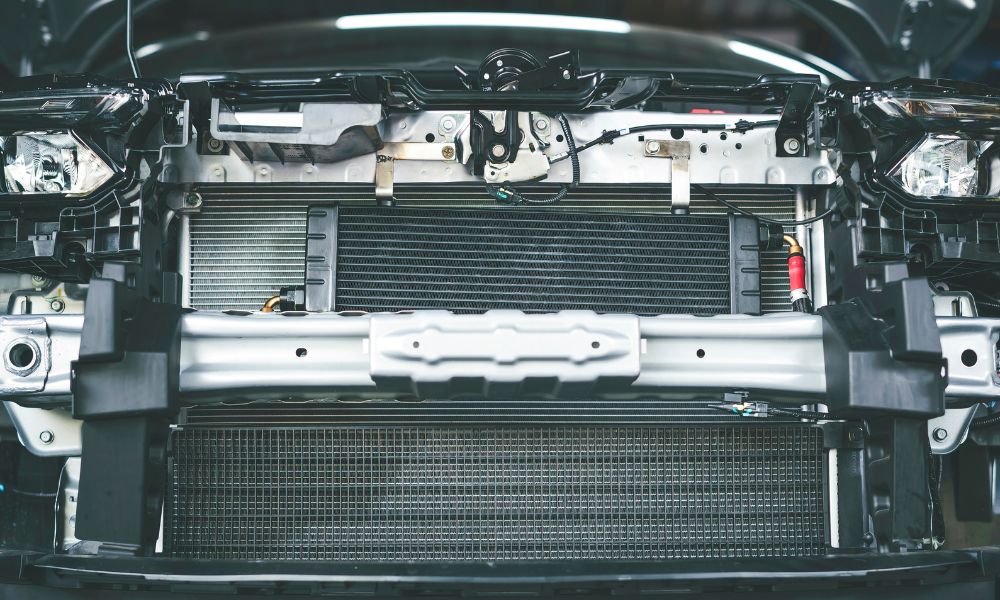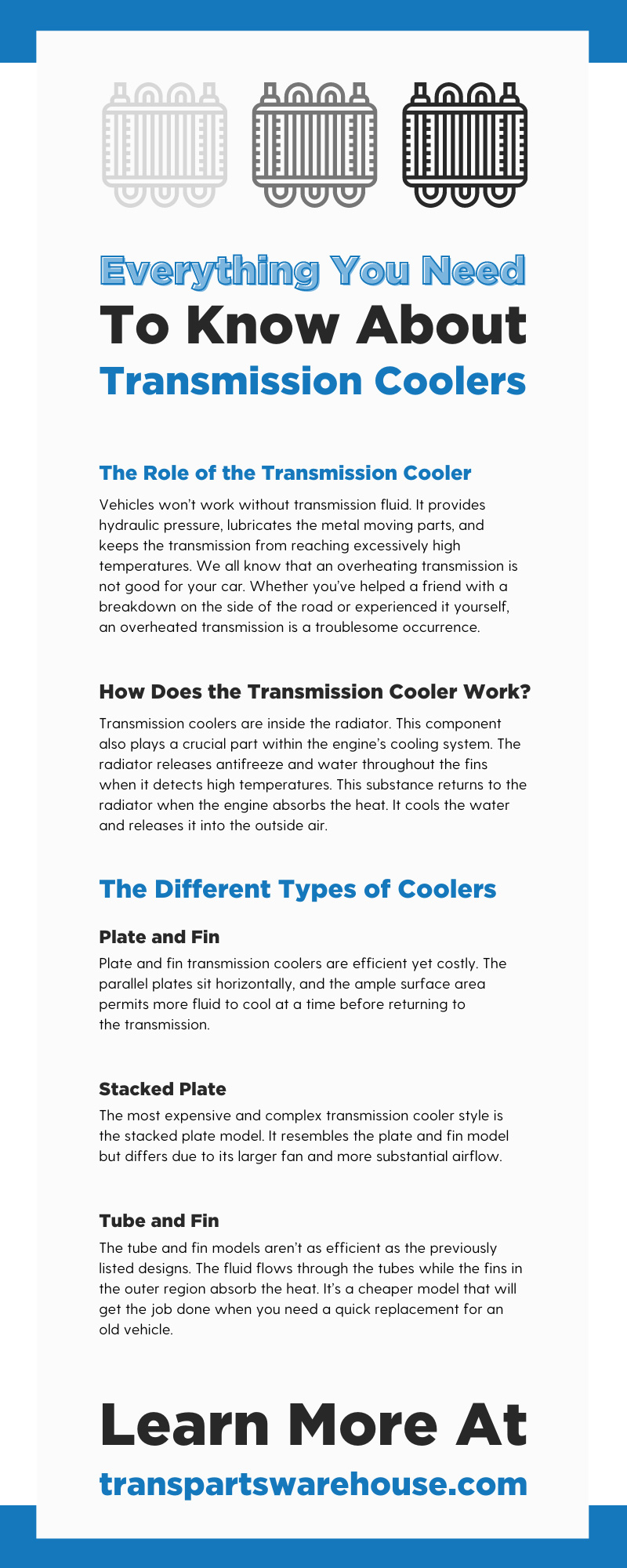
A car can’t run without the right combination of parts. Each component matters, from the brake pads to the filters to the smallest washers. One feature that your car can’t function without is the transmission cooler. If you’ve never heard of this part before and want to understand the ins and outs, continue reading everything you need to know about transmission coolers.
The Role of the Transmission Cooler
Vehicles won’t work without transmission fluid. It provides hydraulic pressure, lubricates the metal moving parts, and keeps the transmission from reaching excessively high temperatures.
We all know that an overheating transmission is not good for your car. Whether you’ve helped a friend with a breakdown on the side of the road or experienced it yourself, an overheated transmission is a troublesome occurrence. Fortunately, automatic cars utilize a transmission cooler, which cools transmission fluid and prevents the transmission from overheating or falling apart altogether.
How Does the Transmission Cooler Work?
Although you now understand the role of the transmission cooler, that’s not everything you need to know about this key part of automatic transmissions. Let’s dive into how it truly works!
Transmission coolers are inside the radiator. This component also plays a crucial part within the engine’s cooling system. The radiator releases antifreeze and water throughout the fins when it detects high temperatures. This substance returns to the radiator when the engine absorbs the heat. It cools the water and releases it into the outside air.
Fluid heated by the transmission is sent into the radiator, then into the cooler. A long tube sits inside the casing of the transmission cooler. The fluid enters from one side and covers the walls of the tube. While the fluid flows through, the walls of the tube expel excessive heat from the liquid. Then, it exits the pipe and circulates back into the transmission to lubricate each component.
External transmission coolers are available for vehicles that tow heavy loads and are prone to overheating. The added protection will guarantee the transmission and engine don’t overheat while exerting immense power.
The Different Types of Coolers
Let’s learn even more about transmission coolers! Fun fact: vehicles can have one of three types of transmission coolers. Here’s a quick rundown of each type.
Plate and Fin
Plate and fin transmission coolers are efficient yet costly. The parallel plates sit horizontally, and the ample surface area permits more fluid to cool at a time before returning to the transmission.
Stacked Plate
The most expensive and complex transmission cooler style is the stacked plate model. It resembles the plate and fin model but differs due to its larger fan and more substantial airflow.
Tube and Fin
The tube and fin models aren’t as efficient as the previously listed designs. The fluid flows through the tubes while the fins in the outer region absorb the heat. It’s a cheaper model that will get the job done when you need a quick replacement for an old vehicle.
The Repercussions of a Faulty Transmission Cooler
Car owners typically fear an overheating engine or transmission. These two parts generate heat while operating, so they’re at risk of overheating if your vehicle has a faulty transmission cooler.
Transmission fluid should flow at 175–225 degrees Fahrenheit. This safe range allows the fluid to lubricate the transmission thoroughly and avoid overheating. However, trouble arises when the fluid’s temperature exceeds 225 degrees Fahrenheit.
The Signs a Transmission Cooler Is Failing and Needs Repairing
Growing your automotive knowledge will help you keep your vehicle in great shape. Pay attention to the following signs that the transmission cooler is failing so you don’t have to deal with a hefty repair in the future.
Overheating Transmission Fluid Due to a Clogged Cooler
Did you know that the transmission cooler can become clogged? High fluid temperature increases the risk of a clogged cooler. When dirt or an unknown substance blocks the flow of the fluid, the transmission fluid cannot circulate to cool the transmission.
Avoid using a cooler flushing solvent to eradicate the cause of the clogged cooler. The solvent can push the substance toward the transmission and lead to further complications. Use a transmission cooler flushing machine for safe, thorough cleanings.
The “Check Engine Light” Appears on the Dashboard
When you open the hood of the car, you see all the incredible parts that make your vehicle run. You will notice the transmission is partly beneath the engine. If the transmission overheats, it will likely send heat to the engine.
The heat’s impact on the transmission and engine is detrimental. This circumstance may cause the “check engine light” to illuminate on the dashboard. Take your vehicle to a mechanic to run the code, or use a car code scanner at home to thoroughly diagnose the issue.
A Burning Smell Is Coming From the Hood
A faulty transmission cooler will produce a burning smell, which originates from the burning transmission fluid. As mentioned, transmission fluid should remain around 175–225 degrees Fahrenheit.
The transmission might emit a burning smell for a few reasons. First, the fluid might be contaminated with metal shavings, dirt, or other debris. Resolve this issue by taking the vehicle to a mechanic who will replace the fluid. Second, the transmission cooler line may be leaking. A cracked cooler cannot sufficiently supply fluid throughout the system, which affects the fluid’s temperature. You can fix this problem by checking the cooler for leaks and attempting the repair on your own. If it’s too complicated, a mechanic can help!
Extend the Life of the Transmission With Help From Transparts Warehouse
No matter which complication you find within your car’s transmission cooler, installing a replacement is never a bad idea. The goal is to prolong the life of your transmission, but you can’t accomplish that without a fully functional transmission cooler.
Haul heavy loads, take long road trips, and spend time in the hot summer weather with amazing automatic transmission coolers at Transparts Warehouse. We have wonderful products to maximize heat transfer and keep your transmission cool. When it’s time to replace your vehicle’s transmission cooler, you’ll be ready with a high-quality part to get the job done.


